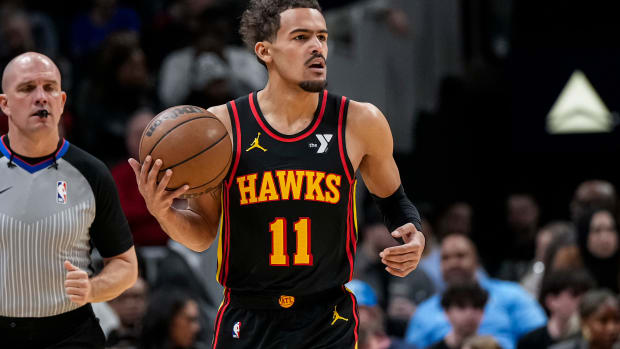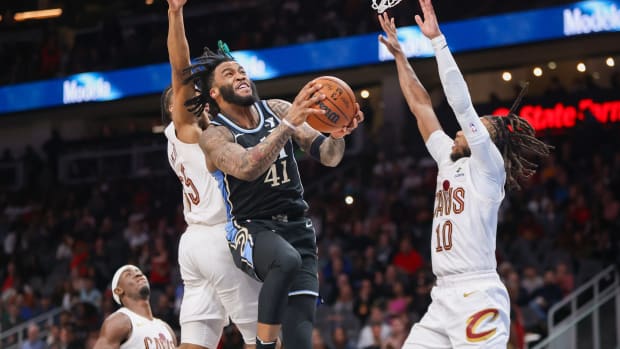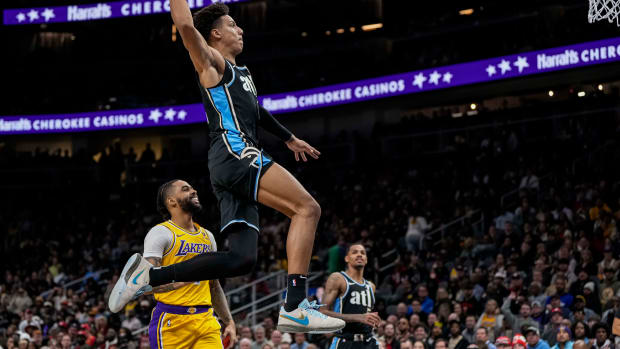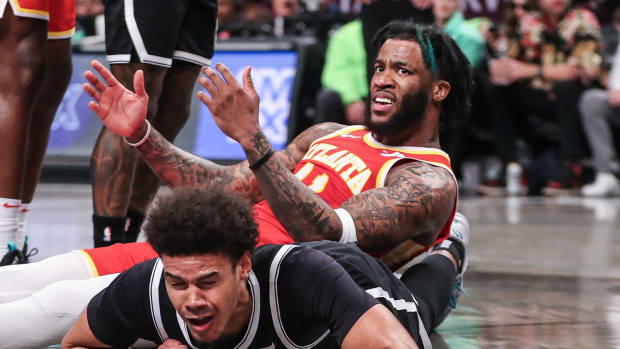How the Hawks can improve an already exciting offense
Young teams confined to the NBA’s cellar are only as good as their habits. Executing sets precisely and consistently, taking the right kinds of shots, and being attentive on defense won’t necessarily translate without the talent to capitalize. But it can serve as a foundation once that talent develops. Establishing a clear and sound process forms the outlines of what might be possible down the line and, occasionally, provides a boost in the near term. The Hawks could benefit from that sort of process in Year 3 of the Travis Schlenk era. Though likely to miss the playoffs again, Atlanta is positioned to build upon an encouraging season by continuing to integrate and execute the philosophies head coach Lloyd Pierce instilled last year.
Calibrating expectations for this team is difficult in large part because of the team’s inconsistency last season. Atlanta outperformed its point differential by nearly five wins in 2019 – the second-largest disparity in the league – and still finished 12 in the Eastern Conference. Can it replicate that type of boost, or its 20-21 record in games decided in the clutch? John Collins missed 21 games while Trae Young had two vastly disparate halves of the season. The team turned over the majority of its roster and will lean on two rookies for rotation minutes.
Offensively, the Hawks have the tools to eventually hum at one of the most efficient rates in the NBA – and possibly crack the top half of the league this season if all goes right. The front office has designed the roster to augment Young’s dynamic shot creation and Collins’ explosive play finishing, and Pierce’s up-tempo system should suit a young, athletic roster. While Atlanta posted one of the worst offensive ratings in the NBA last season, a closer look reveals a slightly rosier view. The Hawks generated the highest shot quality – an estimation of the expected value of a team’s average shot based on location and play context – in the NBA while attempting the third-highest share of threes and layups in the league. Their supercharged offense led the league in pace with Young at the controls, and while that alone doesn’t correlate to efficient offense, it did help Atlanta create easier looks in transition – where possessions are inherently more valuable than in the slower halfcourt game. The Hawks looked to run at every chance, ranking seventh in average length of possession (and third after missed field goals). Young is one of the NBA’s best long-range passers, and his teammates know it:
He manufactures more easy opportunities – both for himself and others – than perhaps any young guard in the league. Some passers merely deliver the ball to teammates already in position to score; Young actively creates advantages by applying constant pressure to opponents and passing teammates open. He already possesses the shooting gravity to warp defenses and the passing vision to exploit openings. Watch as he draws the big man out on the pick-and-roll, causing the weak-side corner defender to slide into the lane and leave Kevin Huerter unguarded:
Few players – let alone rookies – in the NBA can make those sorts of passes consistently, and the Hawks are wise to surround a preternatural playmaker with shooters and roll men who complement him. Those players, however, proved better in theory than in practice. Atlanta simply didn’t make enough shots last season to capitalize on its easy looks. The team converted just 61 percent of its shots at the rim, shot a middling 35 percent from deep, and seldom got to the foul line. The same speed that often catalyzed the offense also lured it into launching ill-advised attempts early in the shot clock, which in turn generated transition chances for opponents. Most notably, Atlanta turned the ball over more often than any team in the NBA. High turnover rates can be indicative of boldness and activity, but those risks simply aren’t worth that many fruitless trips down the floor. Exchanging some of those empty possessions for even an average shot attempt would bolster the offense significantly, and some improvement should be expected from Young, who committed the third-most turnovers in the league as he learned to navigate NBA defenses on the fly.
Lifting itself from the bottom of the league defensively will prove more challenging for Atlanta. No one in the likely starting lineup projects as even an average defender this season, and Young may well have been the worst defensive player in the NBA as a rookie. Evan Turner and DeAndre’ Bembry offer more versatility and awareness off the bench, but each will hinder the team on offense. Whatever his team’s defensive talent or short-term results, Pierce simply wants to see his team take steps in the right direction. “Our growth will be whether or not we overcome pacing and growing and really buying in and committing to the defensive end on a nightly basis,” he said. “For us to advance, for us to progress, it’s going to come down to how we approach the games defensively.”
It could take years for Young to become passable on defense, Collins to shore up his timing and awareness, DeAndre Hunter to round into the sort of all-around stopper the team feels he can be. The most important long-term defensive piece may not yet be on the roster. But it’s clear what this team can be on the other end of the floor, and for the time being it must invest in the process and develop productive long-term habits. That, in time, could make all the difference.
Top photo courtesy of the Atlanta Hawks. Credit: Andy Bower, Atlanta Hawks





